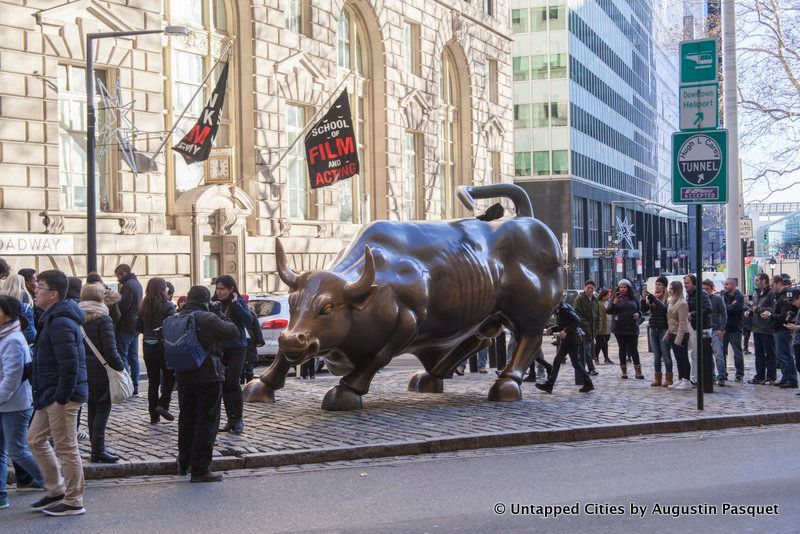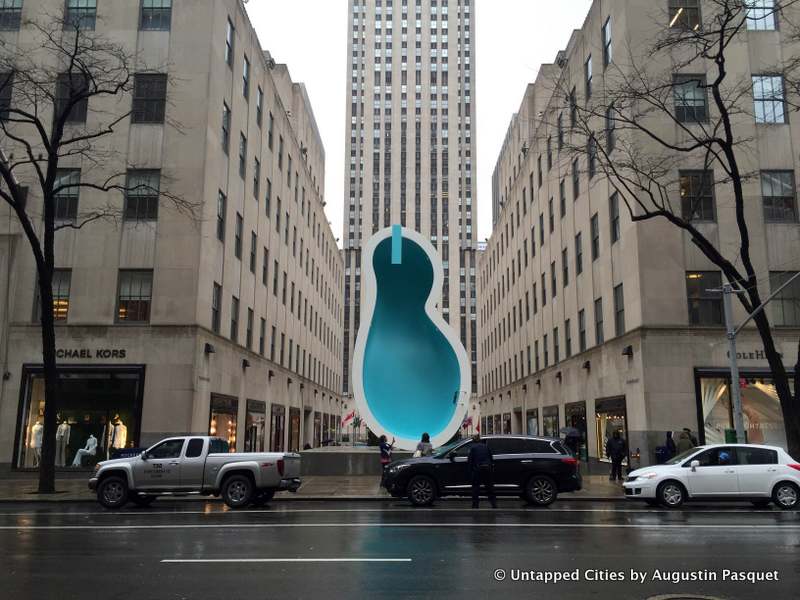Last-Minute NYC Holiday Gift Guide 🎁
We’ve created a holiday gift guide with presents for the intrepid New Yorker that should arrive just in time—


Take a stroll around Lower Manhattan, and you might notice the abundance of public art on display. While many tend to associate the area with finance and business, it is, in fact, an accessible hub of artwork, which has been compared to an “open-air museum.” According to the Downtown Alliance, the walkable square mile south of Chambers Street is actually filled with permanent and temporary public art installations, including Isamu Noguchi’s Red Cube (1968), Arturo di Modica’s Charging Bull (1989) and John Seward Johnson II’s Double Check (1982) in Zuccotti Park.

Arturo di Modica’s Charging Bull (1989) was installed as a symbol of optimism following the 1987 stock market crash
Of course, that’s only the tip of the iceberg—there’s so much to see that we’re hosting a walking tour about public art in this historic area. On this two-hour excursion, we’ll take a stroll down Broadway and then meander through Battery Park, taking time to sample artwork from different eras along the way. In the process, we’ll deconstruct each work, discuss details and then share reactions. The first tour kicks off this Sunday, January 22.
Public Art Tour in Lower Manhattan
With all this buzz about public art and the prevalence of outdoor sculptures in New York City, we couldn’t help but wonder about the general guidelines for installing public art—what does it take to bring a sculpture or piece out from the dark interiors of an artist’s personal studio? Here’s what we dug up:
TEMPORARY PUBLIC OUTDOOR ART GUIDELINES
As noted in this Lower Manhattan Cultural Council guide, the specific permit an artist needs (and the process for obtaining it), all boils down to the type of project he/she is looking to carry out. After selecting a potential project site, the artist should consult with its owners/managers (if it’s a private space) or the involved agency/agencies (if it’s a city-owned space). In every case, the best procedure is to call the property managers or visit an agency’s website for the most up-to-date permit requirements, as they are subject to change. The entire process can also take months to complete, so a minimum lead-time may be needed in order to consider a request.
PROJECTS IN NYC PARKS
Across New York City’s five boroughs, temporary public art installations in parks are commissioned through NYC Parks & Recreation. Proposals for projects must be submitted (at least six months prior to intended installation date) by email to artandantiquities@parks.nyc.gov or by mail to the following address below. Submission requirements, including a written description, an installation budget and photos/drawings of existing work, can be found here.
Public Art Coordinator
City of New York, Parks & Recreation
The Arsenal, Central Park, Rm. 20
New York, NY 10065
After doing so, a departmental panel will review the proposal and discuss issues surrounding durability and safety of the artwork. If a project is approved, a license agreement will be issued to the artist, who will be responsible for overseeing the installation, and securing the insurance and funds that are needed.
PERCENT FOR ART IN NYC
Percent for Art, the New York City-wide program has been running since 1982 and run by the Department of Cultural Affairs. The initiative allocates “one percent of the budget for eligible City-funded construction projects to be spent on public art work, on a commission basis for site-specific works. There have been about 274 works completed using a budget of $41 million for commissions, with 100 completed since 2002. The Department of Cultural affairs notes that over 70 are currently in process. Check out an archive of all the projects here and a map of where they’re located here.
There is an ongoing open call for panelists to participate in the selection process for new commissions, but with the recent drama over the Sunbather installation in Long Island City, New York City Council passed new legislation in January 2017 that would require more representatives from the local district on the panel, along with new requirements on transparency.

Art inside a privately-owned public space (POPS) at E 54th St., between 1st and 2nd Avenue
PROJECTS IN PRIVATELY-OWNED BUILDINGS
In order to install an art piece inside or outside a privately-owned building or plaza, permission must first be secured through the site’s owner or management. Their contact information can generally be found on plaques inside lobbies or public areas of the buildings. Many works, like the Noguchi Cube, are commissioned by the building developer directly. Check out this map of POPS around New York City.
PROJECTS IN TRANSPORTATION STRUCTURES OR ON THE STREET
Sometimes, you can come across artwork on places as publicly accessible as the sidewalk. In this case, the artist or organization most likely reached out to the Department of Transportation (DOT) Office of Permit Management, which issues permits for the use of streets and “transportation-related public spaces.” To apply for a permit, artists must visit the DOT office with insurance information and details about the project budget. If the structure or site is operated by a city agency, including the New York Waterway or the Metropolitan Transit Authority (MTA), it is necessary to contact that specific agency. Projects in subway stations, for example, are commissioned through the MTA Arts & Design, which frequently puts out Calls for Artists.

An non-profit organization like the Public Art Fund works with all of the above stakeholders (public agency to private developer) to install public art, like the recent miniature Redwood forest in downtown Brooklyn, the giant shopping list at the entrance of Central Park, the sideways swimming pool, and more. Many of their projects also receive support from the Department of Cultural Affairs and New York City Council.
To learn more, join us on our upcoming Public Art Walking Tour in Lower Manhattan or check out our full list of Behind the Scenes NYC Tours.
Public Art Tour in Lower Manhattan
Next, check out Corporate Lobbies in NYC With A Side of Art and Manhattan’s Privately Owned Public Spaces. Also see photos of 20 Permanent Art Installations in Lower Manhattan.
Subscribe to our newsletter